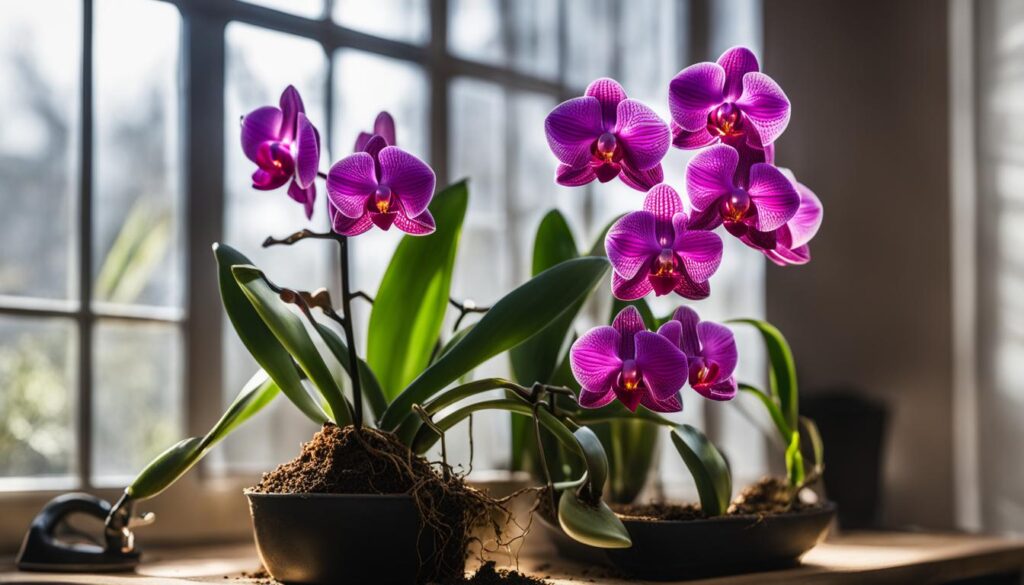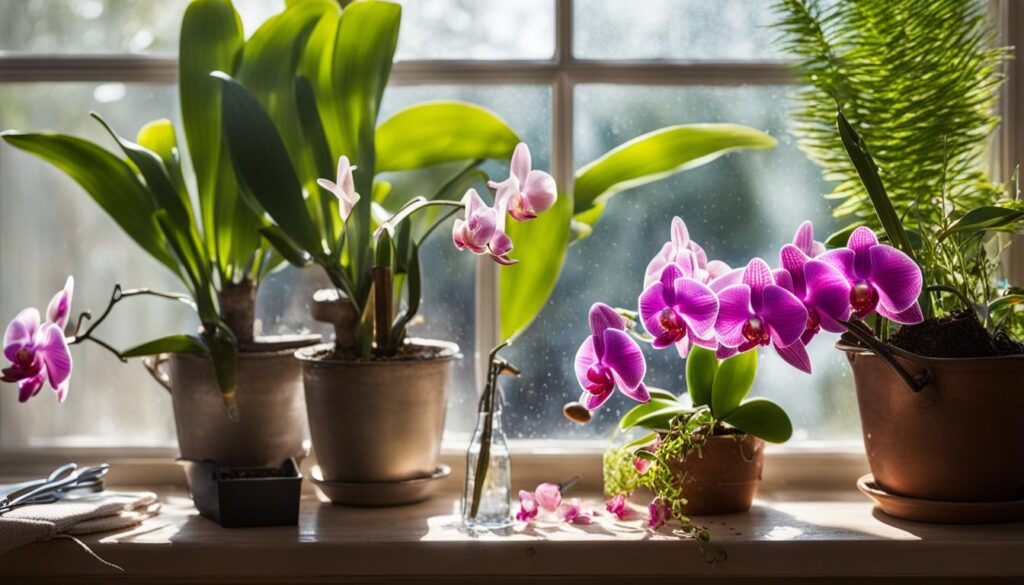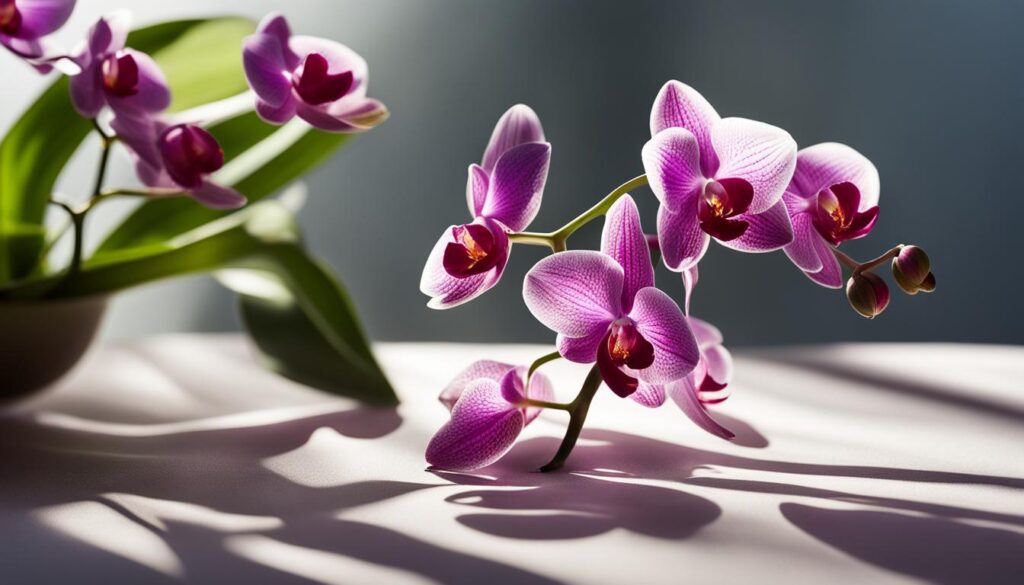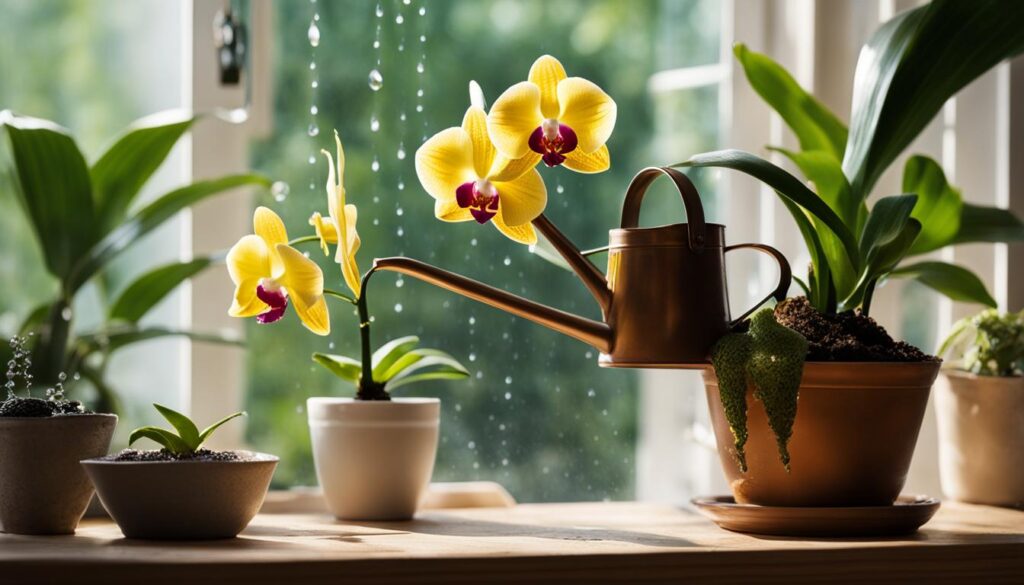Orchid Care Guide: Types, Pruning, Light, Water, Soil, Temperature, Fertilize, Propagating, Growing in Pots & Common Pest Bloom Issues
Orchids are stunning houseplants that require proper care to thrive and bloom. With an incredible variety of over 24,000 species, each orchid has unique needs that must be met to ensure its health and vitality. In this article, I will share valuable tips and insights on how to care for orchids, covering everything from growing and pruning to providing the right light, water, soil, temperature, and fertilizer.

Key Takeaways
- Understanding the specific care requirements of your orchid variety is crucial for successful growth and blooming.
- Proper care involves selecting the appropriate potting medium, providing adequate light, and maintaining a consistent watering routine.
- Choosing the right soil for is essential, with options including bark, moss, rocks, and soilless potting mix.
- Temperature and humidity play a significant role in orchid health, with varying preferences depending on the species.
- Fertilizing orchids during their active growth and flowering periods can promote healthy development, but it’s essential to use a suitable orchid fertilizer and follow the instructions.
Types of Orchids
Orchids are a diverse group of flowering plants, with thousands of species and numerous varieties. Understanding the different types of orchids is crucial for providing proper care. Here are some popular varieties often cultivated as houseplants:
1. Vanda Orchids
Vanda orchids are known for their vibrant colors and large, showy flowers. They are epiphytic, meaning they grow on other plants but do not rely on them for nutrients. Vanda orchids require bright light and high humidity to thrive.
2. Phalaenopsis Orchids
Phalaenopsis orchids, also known as moth orchids, are one of the most popular types of indoor gardening. They feature long-lasting flowers in various colors and are relatively easy to care for. Phalaenopsis orchids prefer lower light conditions compared to some other varieties.
3. Cymbidium Orchids
Cymbidium orchids have long, strap-like leaves and produce large clusters of flowers. They are cold-tolerant, making them suitable for cooler climates. Cymbidium orchids require moderate light and regular watering.
4. Dendrobium Orchids
Dendrobium orchids come in various sizes and colors, with some species having fragrant flowers. They are versatile that can adapt to different growing conditions. Dendrobium orchids prefer bright light and require well-draining growing media.
| Orchid Variety | Light Requirements | Watering Needs | Temperature Range |
|---|---|---|---|
| Vanda Orchids | Bright, indirect light | Regular watering | 70-85°F (21-29°C) |
| Phalaenopsis Orchids | Lower light conditions | Moderate watering | 75-85°F (24-29°C) |
| Cymbidium Orchids | Moderate light | Regular watering | 60-75°F (15-24°C) |
| Dendrobium Orchids | Bright light | Well-draining media | 55-65°F (13-18°C) |
Knowing the specific care requirements for each orchid variety is essential for successfully growing and maintaining these exquisite plants.

How to Grow Orchids
When it comes to growing, providing the right growing conditions is key. Here are some tips to help you successfully care:
Choosing the Potting Medium
It require a well-draining potting medium to ensure proper root health. You can use materials such as bark or sphagnum moss as the potting medium. These materials allow air circulation and prevent waterlogged roots.
Placing Orchids in the Right Light
Orchids need bright, indirect light to thrive. Place them near an east or south-facing window where they can receive ample light throughout the day. Avoid exposing them to direct sunlight, as it can scorch their leaves. If you have orchid varieties that prefer lower light conditions, adjust their placement accordingly.
Watering Orchids Correctly
Proper watering is crucial for orchid growth. Water your orchids once a week during the growing season, allowing water to drain from the bottom of the pot. Avoid overwatering and let the potting medium dry out slightly between waterings. Adjust the watering frequency when the orchid stops blooming to prevent root rot.
Maintaining the Right Temperature and Humidity
Orchids have specific temperature and humidity requirements. Most orchids thrive in temperatures between 60-85 degrees Fahrenheit during the day, with a drop of about 10-15 degrees at night. It’s also important to provide humidity levels between 50-70%. You can achieve this by using humidifiers, pebble trays, or grouping your orchids with other plants.
By following these tips, you can create the ideal conditions for your orchids to grow and thrive. Remember to adjust your care routine based on the specific needs of your orchid variety.
| Orchid Care Tips | Summary |
|---|---|
| Choose a well-draining potting medium | Ensures proper root health |
| Place orchids near an east or south-facing window | Provides bright, indirect light |
| Water orchids once a week, allowing for proper drainage | Avoid overwatering and root rot |
| Maintain temperatures between 60-85 degrees Fahrenheit | Adjust humidity levels between 50-70% |

Pruning Orchids
Pruning orchids is an essential aspect of their care, as it helps stimulate new growth and encourage reblooming. When the flowers on your orchid start to fade, it’s time to consider pruning. Proper pruning techniques vary depending on the health of the orchid and its specific species.
To prune an orchid, you’ll need a pair of sterilized pruning shears or scissors. It’s important to sterilize the tools to prevent the spread of diseases or pests. Before making any cuts, examine the stem of the orchid to determine the best pruning method.
If your orchid has healthy green roots and a stem notch, you can simply trim the stem just above the stem notch. This will allow new buds to emerge and potentially rebloom. However, if your orchid has a brown or unhealthy stem, it’s best to cut the stem about an inch above the base. This will encourage new growth to emerge from the base of the plant.
Remember to be gentle when pruning your orchid to avoid causing any unnecessary damage. With proper pruning, you can help your orchid thrive and produce beautiful blooms for years to come.
Orchid Pruning Guide
| Orchid Condition | Pruning Method |
|---|---|
| Healthy stem with a stem notch | Trim the stem just above the stem notch |
| Brown or unhealthy stem | Cut the stem about an inch above the base |
Orchid Light Requirements
Providing the right amount of light is crucial for the health and blooming of your orchids. Orchids require bright, filtered light to thrive. Placing them near an east or south-facing window is ideal as it provides optimal light conditions. However, it’s important to avoid direct sunlight as it can cause leaf scorch.
Some orchid varieties, such as Phalaenopsis, prefer lower light conditions and can tolerate indirect or lower light levels. If you have Phalaenopsis orchids, you can place them a bit further from the window or use sheer curtains to filter the light. This will help prevent any damage to the leaves while still providing sufficient light for growth and blooming.
When it comes to indoor orchid light, it’s essential to strike a balance. Too little light can result in weak growth and reduced blooming, while too much light can cause leaf burn and damage. Observing your orchids and adjusting their placement as needed will ensure they receive the right amount of light for their specific needs.

Light Levels for Orchid Varieties
| Orchid Variety | Light Requirements |
|---|---|
| Phalaenopsis | Low to medium light |
| Vanda | Bright, indirect light |
| Cymbidium | Medium to bright light |
| Dendrobium | Bright light |
The table above provides an overview of the light requirements for different orchid varieties. Keep in mind that individual orchids within a variety may have slightly different light preferences, so it’s important to observe each plant and make adjustments accordingly.
Orchid Watering Tips
Proper watering is crucial for the health and growth of orchids. Here are some essential tips on how to water orchids effectively:
- Know your orchid’s water requirements: Different orchid species have varying water needs. Some prefer to stay slightly dry between waterings, while others require more frequent watering. It’s essential to research and understand the specific needs of your orchid variety.
- Water thoroughly: When it’s time to water your orchid, ensure thorough watering. Take your orchid to the sink and allow water to flow through the potting medium until it drains from the bottom. This helps flush out any accumulated salts or minerals.
- Avoid overwatering: Overwatering is one of the most common mistakes made when caring for orchids. Allow the potting medium to dry out slightly between waterings to prevent root rot. Stick your finger about an inch into the medium to check if it feels dry before watering again.
- Consider the season: Adjust your watering routine based on the season. During the orchid’s active growing season, usually spring and summer, you may need to water more frequently. In contrast, during the dormant period in fall and winter, reduce watering frequency to avoid waterlogged roots.

By following these simple orchid watering tips, you can ensure that your orchids receive the right amount of water, promoting healthy growth and vibrant blooms.
Watering Frequency for Different Orchid Types
| Orchid Type | Watering Frequency |
|---|---|
| Phalaenopsis (Moth Orchids) | Once every 7-10 days |
| Paphiopedilum (Lady Slipper Orchids) | Once every 7-10 days |
| Cattleya (Corsage Orchids) | Once every 5-7 days |
| Dendrobium (Cane Orchids) | Once every 5-7 days |
| Vanda (Vase Orchids) | Once every 3-5 days |
Keep in mind that these watering frequencies are general guidelines and may vary depending on environmental conditions and the specific needs of your orchids. It’s always best to observe your orchids and adjust your watering routine accordingly.
Best Soil for Orchids
When it comes to orchid care, choosing the right soil is crucial for their growth and overall health. Orchids require a well-draining potting medium that mimics their natural habitat, as they do not grow in regular soil. The type of soil or potting mix you use can greatly impact the moisture retention, aeration, and nutrient availability of your orchids. Here are some options for the best soil for orchids:
Bark-based Potting Mix:
One popular option is a bark-based potting mix, which consists of pieces of redwood or fir bark. This type of mix provides excellent drainage and allows air to circulate around the orchid’s roots. Coarser bark is suitable for Phalaenopsis orchids, while medium bark is preferred for Cattleya orchids.
Sphagnum Moss:
Sphagnum moss is another common choice for orchid potting. It retains moisture well while still allowing for proper drainage. Sphagnum moss is particularly beneficial for orchids that prefer higher humidity levels, such as some species of Dendrobium orchids.
Other Additives:
In addition to bark or moss, some orchid enthusiasts also include other additives in their potting mix. These can include rocks, cork, charcoal, sand, or soilless potting soil. Adding charcoal to the potting mix can help absorb excess moisture and prevent root rot. The specific mix of additives depends on the individual orchid’s needs and the grower’s preferences.
When repotting your orchids, it’s important to choose a pot that allows for proper drainage. Orchid pots with multiple drainage holes or slits are recommended to ensure excess water can escape. Regularly monitoring the moisture levels in the potting mix and adjusting watering accordingly will help maintain optimal conditions for your orchids.
Types of Orchid Potting Mix
| Potting Mix | Benefits | Suitable Orchid Variety |
|---|---|---|
| Bark-based mix | Excellent drainage and aeration | Phalaenopsis, Cattleya |
| Sphagnum moss | Retains moisture, suitable for high humidity | Dendrobium |
| Other additives (rocks, cork, charcoal, etc.) | Customizable mix, absorbs excess moisture | Various orchid varieties |
Remember, each orchid variety may have slightly different soil preferences, so it’s essential to research the specific care requirements for your orchids. Providing the right soil will support their growth and contribute to their overall well-being.
Orchid Temperature and Humidity
Proper temperature and humidity are crucial for orchids to thrive and produce beautiful blooms. Different orchid varieties have varying temperature preferences, so it’s important to understand the specific needs of your orchid. Maintaining the optimal temperature and humidity levels will help your orchid stay healthy and flourish.
Orchid Temperature
Orchids come from diverse habitats, which means they have different temperature requirements. Some orchids prefer cooler temperatures between 60-75 degrees Fahrenheit during the day, while others thrive in temperatures between 70-85 degrees Fahrenheit. To provide the best conditions, aim for a 10-15 degree decrease in temperature at night, as this temperature drop is essential for many orchids to initiate blooming.
Orchid Humidity
Orchids are native to tropical and subtropical regions where humidity levels are high. In order to replicate their natural environment, it’s important to provide adequate humidity for your orchid. The ideal humidity range for orchids is between 50-70%. You can achieve this by using a humidifier, placing your orchid on a pebble tray filled with water, or grouping your orchids together, which creates a microclimate with higher humidity.
| Orchid Variety | Temperature Range (Fahrenheit) | Humidity Range (%) |
|---|---|---|
| Phalaenopsis | 70-85 | 50-70 |
| Cattleya | 65-75 | 50-60 |
| Vanda | 75-95 | 60-80 |
| Dendrobium | 65-85 | 50-70 |
Orchid Fertilizer Guide
Proper fertilization is essential for the healthy growth and blooming of orchids. Understanding the specific fertilizer requirements for orchids can help you provide the necessary nutrients for their optimal development. Here is a comprehensive guide on how to fertilize orchids effectively.
Types of Orchid Fertilizers
There are various types of orchid fertilizers available on the market, including balanced formulations and specialized blends. Balanced fertilizers, such as a 20-20-20 or 10-10-10 ratio, provide equal amounts of nitrogen (N), phosphorus (P), and potassium (K). These are suitable for most orchid varieties. However, certain orchids, such as those grown in the bark or sphagnum moss, may require specialized formulations with higher nitrogen content.
Note: When selecting a fertilizer, it is important to choose one specifically formulated for orchids and follow the manufacturer’s instructions for application.
When to Fertilize
Orchids should be fertilized during their active growth and flowering periods. This typically occurs from spring to fall. During the dormant period, which usually takes place in winter, orchids do not require fertilizer. It is important to avoid over-fertilizing orchids, as this can lead to salt buildup and damage the roots. To determine the appropriate frequency, refer to the fertilizer label or follow a general guideline of fertilizing every two to four weeks during active growth.
You can also read Homemade Organic Liquid Fertilizers
How to Apply Fertilizer
When applying fertilizer to orchids, it is essential to dilute the concentrated solution according to the manufacturer’s guidelines. Overdosing can harm the plants. The fertilizer solution should be applied evenly to the orchid’s root zone and not directly onto the leaves or flowers. Applying fertilizer to wet roots can also help prevent burning or damaging the plant. Many growers prefer to water their orchids first before applying the fertilizer solution.
| Fertilizer | Nitrogen (N) | Phosphorus (P) | Potassium (K) |
|---|---|---|---|
| 20-20-20 | 20% | 20% | 20% |
| 10-10-10 | 10% | 10% | 10% |
| Specialized Blend | Varies | Varies | Varies |
- Choose a fertilizer specifically formulated for orchids.
- During active growth and flowering periods, fertilize every two to four weeks.
- Dilute the fertilizer according to the manufacturer’s instructions.
- Apply the fertilizer solution evenly to the orchid’s root zone.
- Avoid direct contact with leaves and flowers.
- Water the orchid before applying the fertilizer solution.
- Monitor the orchid’s response to the fertilizer and adjust the frequency or strength as needed.
By following this orchid fertilizer guide, you can ensure that your orchids receive the necessary nutrients for healthy growth and vibrant blooms. Remember to monitor your orchids’ response to fertilization and make adjustments as needed to ensure their long-term health and beauty.
You can also read How to Grow and Care Curry Leaf Plant and Tree
Orchid Pests and Diseases
While orchids are generally resilient plants, they can still fall victim to pests and diseases. It’s essential to identify and address these issues promptly to ensure the health and well-being of your orchids. Here are some common pests and diseases that can affect orchids:
Pests:
- Mealybugs: These small, white insects can cause damage by feeding on the sap of the orchid. Look for cotton-like masses on the leaves and stems.
- Spider Mites: These tiny pests can be identified by the fine webbing they create on the plant. Spider Mites can cause yellowing and curling of the leaves.
- Scale Insects: These pests appear as small, waxy bumps on the leaves and stems of the orchid. They can cause yellowing and stunted growth.
- Thrips: Thrips are slender insects that feed on the leaves and flowers, leaving behind silver streaks or spots.
- Aphids: Aphids are small, soft-bodied insects that can cluster on the leaves and buds, causing distortion and discoloration.
Diseases:
- Leaf Spots: Leaf spots are fungal or bacterial infections that appear as discolored spots on the leaves. They can be caused by overwatering or poor air circulation.
- Petal Blight: Petal blight is a fungal infection that causes browning and rotting of the petals. It thrives in humid conditions and can spread quickly.
- Bacterial Soft Rot: Bacterial soft rot can cause the orchid’s leaves and pseudobulbs to become soft and mushy. It is often a result of overwatering or damage to the plant.
- Viruses: Orchids can also be affected by various viral infections, which can cause distorted growth, mottled leaves, and other abnormalities.
To prevent and manage pests and diseases, it’s important to maintain good orchid care practices. This includes providing proper lighting, watering, and ventilation, as well as regular inspection of your plants. If you notice any signs of pests or diseases, isolate the affected orchid and treat it accordingly. In some cases, it may be necessary to use insecticidal soaps, fungicides, or other treatments to control the infestation or infection.
Troubleshooting Orchid Problems
Orchids are beautiful plants, but sometimes they can face common issues that require troubleshooting. Understanding these problems and their solutions can help you provide the best care for your orchids. Here are some common orchid issues and how to address them:
Lack of Flowering
If your orchid isn’t flowering, there could be several reasons. It may not be getting enough light or the right temperature. Make sure your orchid is placed near a window with bright, indirect light, and adjust the temperature according to its specific needs. Another factor to consider is fertilizer. Ensure you are providing the right type and amount of fertilizer during the active growth period.
Leaf Loss
When your orchid starts losing leaves, it might be a sign of stress or incorrect care. Check the light, temperature, and humidity levels to ensure they are suitable for your orchid variety. Overwatering or underwatering can also cause leaf loss, so adjust your watering routine accordingly. Providing the right potting medium and repotting when necessary can also prevent leaf loss.
Yellowing Leaves
If your orchid’s leaves are turning yellow, it could be a sign of nutrient deficiency or root problems. Check your orchid’s fertilization routine and make sure you are providing the necessary nutrients. Additionally, inspect the roots for any signs of rot or damage. Trim any unhealthy roots and repot the orchid using a fresh, well-draining potting medium.
Crinkly Leaves and Exposed Roots
Crinkly leaves and exposed roots can indicate dehydration or poor humidity levels. Ensure you are watering your orchid properly and providing enough humidity. Mist the leaves regularly or use a humidity tray to increase moisture around the plant. If the roots are exposed, consider repotting the orchid or adding a layer of moss to cover them.
By troubleshooting these common orchid issues, you can ensure your plants stay healthy and vibrant. Remember to observe your orchids closely, adjust their care as needed, and provide the ideal growing conditions for each specific variety.
FAQ
What are the types of orchids?
Some of the popular types of orchids for indoor gardening include Vanda orchids, Phalaenopsis (moth orchids), Cymbidium orchids, and Dendrobium orchids.
How do I grow orchids?
To grow orchids, provide the right growing conditions such as choosing the appropriate potting medium, ensuring proper drainage, placing them near an east or south-facing window for bright, indirect light, regular watering without overwatering, maintaining the right temperature and humidity levels.
How do I prune orchids?
After the flowers fade, trim the stem just above the stem notch or cut an inch above the base of the stem, using sterilized tools and being gentle to avoid damaging the plant.
What are the light requirements for orchids?
Orchids require bright, filtered light and should be placed near an east or south-facing window. Some orchid varieties prefer lower light conditions and should be protected from direct sunlight.
How should I water orchids?
Orchids should be watered once a week during the growing season, allowing water to drain from the pot’s bottom. Reduce watering frequency when the orchid stops blooming, let the growing medium dry out slightly between waterings, and avoid overwatering to prevent root rot.
What is the best soil for orchids?
Orchids require a well-draining potting medium and do not grow in regular soil. Options include redwood or fir bark, sphagnum moss, rocks, cork, charcoal, sand, or soilless potting soil, depending on the orchid variety.
What temperature and humidity do orchids need?
Orchids have varying temperature preferences, with some preferring cooler temperatures between 60-75 degrees F during the day and a decrease of 10-15 degrees at night. They also require humidity levels between 50-70%, which can be achieved through the use of humidifiers, pebble trays, or grouping them with other plants.
How do I fertilize orchids?
Orchids need fertilizer during their active growth and flowering periods. Use a water-soluble fertilizer specifically formulated for orchids and follow the instructions on the label. The fertilizer ratio may vary depending on the orchid variety.
What pests and diseases affect orchids?
Orchids can be susceptible to pests such as mealybugs, spider mites, scale, thrips, and aphids. They may also experience leaf spots, petal blight, bacterial soft rot, and viruses. Regular inspection and maintenance can help prevent and manage these issues.
What are common problems with orchids?
Common problems with orchids include lack of flowering, leaf loss, sticky residues on leaves, crinkly leaves, exposed roots, and yellowing leaves. These issues can be attributed to various factors such as incorrect watering, lighting, and temperature conditions.




